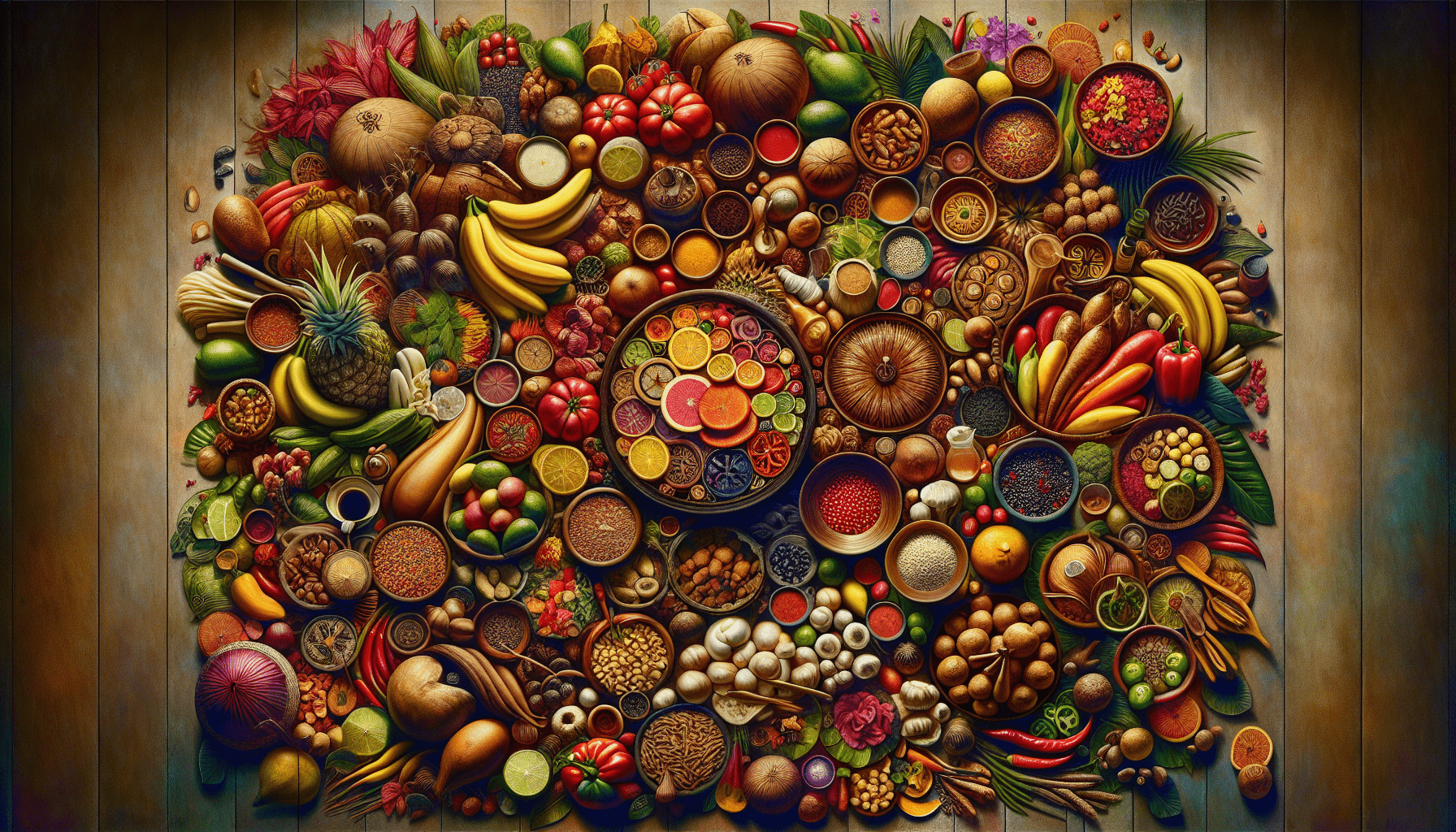Are you curious about the flavors of Surinamese cuisine? Look no further! This guide will introduce you to the key ingredients that make Surinamese dishes so unique and delicious. From aromatic spices to tropical fruits, Surinamese cuisine is a delightful fusion of cultures, offering a delectable array of flavors for both adventurous food enthusiasts and beginners alike. So, grab your apron and get ready to embark on a culinary journey through the vibrant and diverse world of Surinamese cuisine!
Rice
Rice is a staple in Surinamese cuisine and plays a crucial role in many of our dishes. Suriname has a rich culinary heritage influenced by various cultures, including Indian, Chinese, Javanese, and African. Each culture brings its own unique touch to the preparation and consumption of rice.
In Suriname, you will find a wide variety of rice used in our dishes. The most commonly used is white rice, which is fluffy and pairs well with many different flavors. Another popular variety is brown rice, known for its nutty flavor and slightly chewy texture. We also enjoy using fragrant rice, such as jasmine and basmati, to add an aromatic element to our dishes. These different varieties of rice allow for versatility in cooking and provide a diverse range of textures and flavors.
Marinades and Sauces
Surinamese cuisine is heavily influenced by Indian, Chinese, and Javanese flavors, and our marinades and sauces reflect this fusion of culinary traditions. Marinades are used to infuse meat, poultry, and seafood with flavor before cooking, while sauces are often used as a finishing touch or for dipping.
One of the most popular marinades in Surinamese cuisine is masala, a spice blend consisting of various aromatic spices, such as cumin, coriander, turmeric, and cloves. This marinade is commonly used in dishes like chicken masala and beef curry. Another common marinade is kecap manis, a sweet and savory soy sauce originating from Indonesian cuisine. It adds a distinct flavor to dishes like satay and nasi goreng.
When it comes to sauces, Surinamese cuisine offers a wide range of options. Pindasaus, a peanut sauce made with ground peanuts, garlic, and spices, is a beloved accompaniment to many dishes. Ketjap sauce, a thick and sweet soy sauce, is often drizzled over fried rice or noodles for a burst of flavor. These rich and flavorful sauces are what make Surinamese dishes truly stand out.

Spices and Herbs
Surinamese cuisine is known for its unique blend of spices and herbs, which add depth and complexity to our dishes. The combination of Indian, Chinese, Javanese, and African flavors creates a tantalizing mix that has become a hallmark of our cuisine.
Some commonly used spices in Surinamese dishes include cumin, coriander, turmeric, cloves, and cardamom. These spices lend a warm and earthy flavor to our dishes, while also providing various health benefits. In addition to spices, herbs like cilantro, parsley, and lemongrass are frequently used to add freshness and brightness to our meals.
The precise blend of spices and herbs varies from dish to dish, giving each recipe its own distinct flavor profile. Surinamese cuisine takes pride in its ability to balance these flavors, resulting in dishes that are both aromatic and delicious.
Meats
When it comes to meats, Surinamese cuisine offers a wide variety of options. The fusion of cultural influences has led to an eclectic mix of meat dishes that are sure to satisfy any carnivorous cravings.
Chicken and beef are among the most commonly used meats in Surinamese cuisine. They are often marinated in flavorful spices, such as masala or kecap manis, and then cooked to perfection. These meats can be enjoyed in various dishes like chicken curry, beef stew, and grilled kebabs.
Suriname’s proximity to the Atlantic Ocean also means that seafood plays a prominent role in our cuisine. Shrimp, fish, and crab are popular choices and are often incorporated into dishes like fried rice, seafood soups, and spicy curries.
In addition to chicken, beef, and seafood, Surinamese cuisine also features other meats like lamb, goat, and pork. These meats are commonly used in traditional dishes prepared for special occasions and celebrations. The variety of meats available in Surinamese cuisine ensures that there is always something for everyone to enjoy.

Fish and Seafood
With its proximity to the Atlantic Ocean and Suriname River, Surinamese cuisine boasts a rich variety of fish and seafood dishes. From freshwater fish to saltwater delicacies, there is an abundance of options to satisfy any seafood lover’s palate.
One of the most popular fish used in Surinamese cuisine is the tilapia. It is often marinated in a variety of spices and grilled to perfection. Other popular fish varieties include red snapper, catfish, and pomfret, which are used in dishes like fish curry, fish cakes, and fish soups.
Suriname’s coastal location also allows for an impressive selection of shellfish and crustaceans. Shrimp, crab, and lobster are commonly used in dishes like garlic butter shrimp, crab soup, and lobster bisque. The flavors of these seafood dishes are enhanced by the use of aromatic spices and herbs, creating a culinary experience that is both vibrant and exquisite.
Vegetables
Vegetables play a vital role in Surinamese cuisine, adding color, texture, and nutrition to our dishes. Suriname’s fertile soil and tropical climate provide the perfect conditions for growing a wide array of vegetables.
Some commonly used vegetables in Surinamese cuisine include okra, eggplant, pumpkin, and bitter gourd. These vegetables are often incorporated into stews, curries, and stir-fried dishes. Leafy greens like spinach and kale are also popular choices and are used in salads, side dishes, and soups.
The use of vegetables in Surinamese cuisine goes beyond traditional recipes. Many Surinamese households cultivate their gardens, allowing them to enjoy a variety of homegrown produce. This emphasis on fresh and locally sourced vegetables ensures that every meal is packed with flavor and nutrition.
Legumes
Legumes play an important role in Surinamese cuisine, providing a significant source of protein and fiber. They are versatile ingredients used in a variety of dishes, from hearty stews to savory soups.
The most commonly used legumes in Surinamese cuisine include black-eyed peas, lentils, kidney beans, and chickpeas. These legumes are often combined with meats or vegetables to create delicious and satisfying meals. Traditional dishes like brown beans with rice, dhal, and cassava soup are popular choices among Surinamese households.
Legumes not only add depth and texture to Surinamese dishes but also offer numerous health benefits. Their high fiber content promotes digestive health, while their protein content makes them a valuable source of nutrients for vegetarians and vegans.
Fruits
Suriname is blessed with an abundance of tropical fruits, which are a significant component of our cuisine. From refreshing snacks to decadent desserts, Surinamese fruits are a delight to both the palate and the senses.
Some of the most popular fruits used in Surinamese dishes include bananas, mangoes, pineapples, and papayas. These fruits are often enjoyed on their own, added to salads, or used as ingredients in fruit-based desserts like fruit salad and sorbet.
Another beloved fruit in Surinamese cuisine is the Surinam cherry, also known as pitanga or cerise. Its sweet and tangy flavor is often used to make jams, syrups, and juices. The versatility of Surinamese fruits allows for endless possibilities when it comes to incorporating them into our dishes, making every meal a tropical delight.
Condiments
Condiments are an indispensable part of Surinamese cuisine, adding a final touch of flavor and complexity to our dishes. With their bold and tangy flavors, these condiments elevate the overall dining experience.
One of the most iconic condiments in Surinamese cuisine is sambal, a hot chili paste made with fresh chili peppers, garlic, and lime juice. It is a staple on every Surinamese dining table and is used to add heat and spice to dishes like roti and saoto soup. Another popular condiment is mango chutney, made with ripe mangoes, spices, and vinegar. It adds a sweet and tangy flavor to curries and grilled meats.
Surinamese cuisine also features pickles, such as piccalilli and kasiri, which are made from a variety of vegetables and spices. These pickles provide a refreshing and zesty accompaniment to many dishes, balancing out the richness of meats and curries.
Beverages
When it comes to beverages, Surinamese cuisine offers a range of traditional drinks that are both refreshing and flavorful. These beverages, often enjoyed with meals or as standalone refreshments, provide a glimpse into our rich cultural heritage.
One of the most well-known traditional beverages in Surinamese cuisine is djogo, a refreshing beer infused with local flavors like ginger and sorrel. This beer is often enjoyed during social gatherings and celebrations. Another popular drink is markoesa juice, made from passion fruit, which is known for its sweet and tangy flavor.
For those looking for non-alcoholic options, Surinamese cuisine also offers refreshing drinks like dawet, a sweet coconut milk beverage infused with pandan leaves, and citrus-infused water, commonly known as warangi. These beverages are perfect for quenching your thirst on a hot day, providing a burst of tropical flavors.
In conclusion, Surinamese cuisine is a vibrant fusion of flavors, incorporating influences from Indian, Chinese, Javanese, and African culinary traditions. With its diverse array of ingredients, Surinamese dishes offer a unique and tantalizing experience for food enthusiasts. From the staple ingredient of rice to the rich variety of meats, fish, vegetables, legumes, fruits, condiments, and beverages, Surinamese cuisine has something to satisfy every palate. So, next time you’re looking to explore a new culinary adventure, consider diving into the world of Surinamese cuisine and discover the wonders it has to offer.